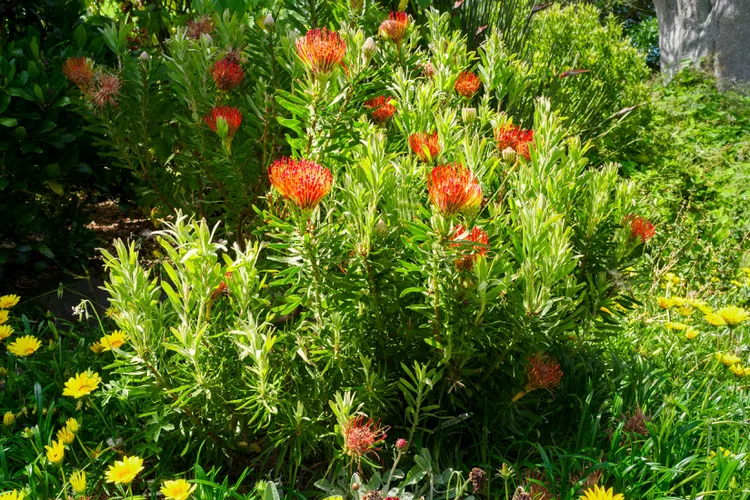
Protea is a genus of over 50 species of flowering trees and shrubs that are indigenous to Australia and South Africa and members of the Proteaceae family. They are also known as “sugar bushes” because they produce a lot of nectar. Proteas can be found in a wide range of sizes and shapes. Typically, the flowers come in orange, red, white, pink, and yellow hues.
Characteristics of Protea
Proteas can develop into both small shrubs and towering trees, depending on their habitat. Its tubular flowers have huge outer bracts, which resemble colorful modified leaves and spiral around the stem. The bracts, which are typically rigid and leathery, can be pointy, rounded, oval, or paddle-shaped. Together, they enclose an inner mass with long tubular florets that are formed like a cone. Because of their numerous vivid colors, including cream, orange, red, pink, and yellow, proteas are simple to identify.
Care
In areas with hot, sunny conditions where many other types of flowering plants might not survive, protea flourish. They can withstand some very difficult environments thanks to their thick, rigid leaves.

Light
Provide plants plenty of airflow and direct sunlight; the more sunlight, the more blossoms will grow.
Soil
The soil must drain extremely well for protea plants. They may grow in nearly any sort of soil, whether it is sandy, rocky, or loamy, as long as the drainage is good. The plants are perfect for a rocky area of the garden since their roots can spread practically horizontally, just below the soil surface. Avoid allowing water to sit on the soil as the roots may become flooded, which will likely result in the plant dying. Increase drainage while growing proteas outdoors by incorporating bark and grit into the soil.
Water
Water plants frequently as they begin to establish themselves. Once every two to three weeks should established plants be watered. When the weather is dry and the plant is around a year old, water it once a week when it starts to set buds and blooms.
Temperature and Humidity
Proteas may endure temperatures as low as 23 degrees Fahrenheit provided they are planted in the appropriate climate and hardiness zone for the particular species (sometimes lower). They can also withstand temperatures of up to 100 degrees Fahrenheit, but they will perish if exposed to greater temperatures for an extended period of time. Proteas should not be planted in areas with excessive humidity.
Fertilizer
Often, proteas don’t require fertilizer. They may even perish from an excess of phosphorus. Take special care not to disrupt the shallow roots by doing so. Put a layer of bark or leaves as a mulch far from the trunk. Hand-pull any weeds with care.
Pruning
Protea flowers are excellent for both dry and fresh bouquets because of their vibrant colour and luxuriant form and texture. The plant can be kept neater by collecting the blossoms. Remove the majority of the stalk and the discarded flower heads to make room for future growth. Young plants should be pruned in the spring and summer to promote bushiness. Cut off unflowered stems; they will blossom the following season.
Potting and Repotting
Mix peat, gravel, and sand in equal portions for potted proteas. They thrive in soil with few nutrients.
Table





